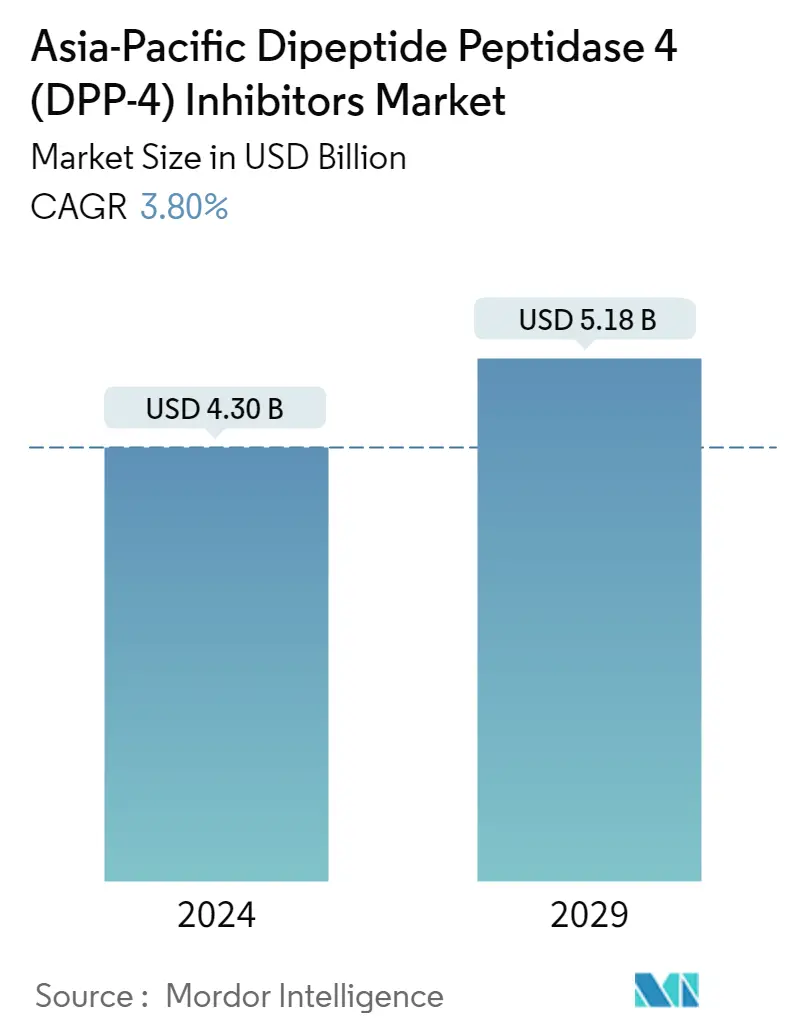Market Size of Asia-Pacific Dipeptide Peptidase 4 (DPP-4) Inhibitors Industry

| Study Period | 2018 - 2029 |
| Base Year For Estimation | 2023 |
| Forecast Data Period | 2024 - 2029 |
| Market Size (2024) | USD 4.30 Billion |
| Market Size (2029) | USD 5.18 Billion |
| CAGR (2024 - 2029) | 3.80 % |
Major Players
*Disclaimer: Major Players sorted in no particular order |
Asia-Pacific Dipeptide Peptidase 4 (DPP-4) Inhibitors Market Analysis
The Asia-Pacific Dipeptide Peptidase 4 Inhibitors Market size is estimated at USD 4.30 billion in 2024, and is expected to reach USD 5.18 billion by 2029, growing at a CAGR of 3.80% during the forecast period (2024-2029).
The COVID-19 pandemic positively impacted the Asia-Pacific Dipeptide Peptidase 4 (DPP-4) Inhibitors Market. Diabetes and uncontrolled hyperglycemia are risk factors for poor outcomes in patients with COVID-19 including an increased risk of severe illness or death. People with diabetes have a weaker immune system, the COVID-19 complication aggravates the condition, and the immune system gets weaker very fast. In the current crisis, type 2 diabetes patients are at much higher risk.
Dipeptidyl peptidase 4 (DPP-4) inhibitors are a class of medicine that lower high blood glucose levels and are used in the treatment of type 2 diabetes. DPP4 inhibitors increase insulin and GLP-1 secretion and are commonly prescribed for people suffering from type 2 diabetes. The use of DPP4 inhibitors in patients with COVID-19 with or even without type 2 diabetes offers a simple way to reduce the virus entry and replication into the airways and to hamper the sustained cytokine storm and inflammation within the lung in patients diagnosed with COVID-19 infection.
The COVID-19 pandemic emphasizes the need for good glycemic control in patients with diabetes, in large part because most observational studies have reported that poorly controlled diabetes is associated with a higher risk for hospitalization and death from a viral illness. Diabetes mellitus has been of wide concern with its high prevalence, resulting in increased financial burdens for clinical systems, individuals, and governments. The market players are adopting various strategies such as collaborations, partnerships, mergers, acquisitions, and expansions to increase market share. Technological advancements have increased over the period leading to several modifications either in the DPP-4 Inhibitor drugs or the formulations being developed.
Therefore, owing to increased diabetes prevalence and the aforementioned factors the studied market is anticipated to witness growth over the analysis period.
Asia-Pacific Dipeptide Peptidase 4 (DPP-4) Inhibitors Industry Segmentation
Dipeptidyl peptidase 4 (DPP-4) inhibitors are a pharmacological class for treating Type 2 diabetes. They help to control glycemia by increasing the levels of active incretins. The Asia-Pacific Dipeptide Peptidase 4 (DPP-4) Inhibitors Market is segmented into drugs (Sitagliptin (Januvia), Saxagliptin (Onglyza), Linagliptin (Tradjenta), Alogliptin (Vipidia/Nesina), Vildagliptin (Galvus), and others), and geography (Australia, China, India, Indonesia, Japan, Malaysia, Philippines, South Korea, Thailand, Vietnam, and rest of Asia-Pacific). The report offers the value (in USD million) and volume (in units million) for the above segments. Further, the report will cover a segment-wise breakdown (value and volume) for all the countries covered under the Table of Contents.
| Drug | |
| Januvia (Sitagliptin) | |
| Onglyza (Saxagliptin) | |
| Tradjenta (Linagliptin) | |
| Vipidia/Nesina (Alogliptin) | |
| Galvus (Vildagliptin) | |
| Others |
| Geography | |
| Australia | |
| China | |
| India | |
| Indonesia | |
| Japan | |
| Malaysia | |
| Philippines | |
| South Korea | |
| Thailand | |
| Vietnam | |
| Rest of Asia-Pacific |
Asia-Pacific Dipeptide Peptidase 4 (DPP-4) Inhibitors Market Size Summary
The Asia-Pacific Dipeptide Peptidase 4 (DPP-4) Inhibitors Market is poised for significant growth, driven by the increasing prevalence of diabetes and the rising demand for effective glucose-lowering medications. DPP-4 inhibitors, a class of drugs used to manage type 2 diabetes, have gained prominence due to their ability to enhance insulin secretion and reduce blood glucose levels without the risk of hypoglycemia. The market is experiencing a positive impact from the COVID-19 pandemic, as individuals with diabetes are at a higher risk of severe complications from the virus, highlighting the importance of maintaining good glycemic control. The region's market landscape is characterized by a mix of global pharmaceutical giants and local manufacturers, with China holding a substantial market share due to its high diabetes prevalence and ongoing efforts to improve diabetes management and care.
The market's growth trajectory is supported by technological advancements and strategic initiatives such as collaborations, mergers, and expansions among key players like Eli Lilly, AstraZeneca, Merck, and Novartis. These companies are actively working to enhance their market presence and develop innovative formulations of DPP-4 inhibitors. The introduction of new-generation oral anti-diabetic drugs, such as sitagliptin-based combinations, is further propelling market expansion. The Asia-Pacific region, particularly countries like China and India, is witnessing a surge in diabetes cases, driven by factors such as urbanization, aging populations, and lifestyle changes. This increasing incidence underscores the need for effective diabetes management solutions, positioning the DPP-4 inhibitors market for continued growth in the coming years.
Asia-Pacific Dipeptide Peptidase 4 (DPP-4) Inhibitors Market Size - Table of Contents
-
1. MARKET DYNAMICS
-
1.1 Market Overview
-
1.2 Market Drivers
-
1.3 Market Restraints
-
1.4 Porter's Five Forces Analysis
-
1.4.1 Bargaining Power of Suppliers
-
1.4.2 Bargaining Power of Consumers
-
1.4.3 Threat of New Entrants
-
1.4.4 Threat of Substitute Products and Services
-
1.4.5 Intensity of Competitive Rivalry
-
-
-
2. MARKET SEGMENTATION
-
2.1 Drug
-
2.1.1 Januvia (Sitagliptin)
-
2.1.2 Onglyza (Saxagliptin)
-
2.1.3 Tradjenta (Linagliptin)
-
2.1.4 Vipidia/Nesina (Alogliptin)
-
2.1.5 Galvus (Vildagliptin)
-
2.1.6 Others
-
-
2.2 Geography
-
2.2.1 Australia
-
2.2.2 China
-
2.2.3 India
-
2.2.4 Indonesia
-
2.2.5 Japan
-
2.2.6 Malaysia
-
2.2.7 Philippines
-
2.2.8 South Korea
-
2.2.9 Thailand
-
2.2.10 Vietnam
-
2.2.11 Rest of Asia-Pacific
-
-
Asia-Pacific Dipeptide Peptidase 4 (DPP-4) Inhibitors Market Size FAQs
How big is the Asia-Pacific Dipeptide Peptidase 4 (DPP-4) Inhibitors Market?
The Asia-Pacific Dipeptide Peptidase 4 (DPP-4) Inhibitors Market size is expected to reach USD 4.30 billion in 2024 and grow at a CAGR of 3.80% to reach USD 5.18 billion by 2029.
What is the current Asia-Pacific Dipeptide Peptidase 4 (DPP-4) Inhibitors Market size?
In 2024, the Asia-Pacific Dipeptide Peptidase 4 (DPP-4) Inhibitors Market size is expected to reach USD 4.30 billion.

